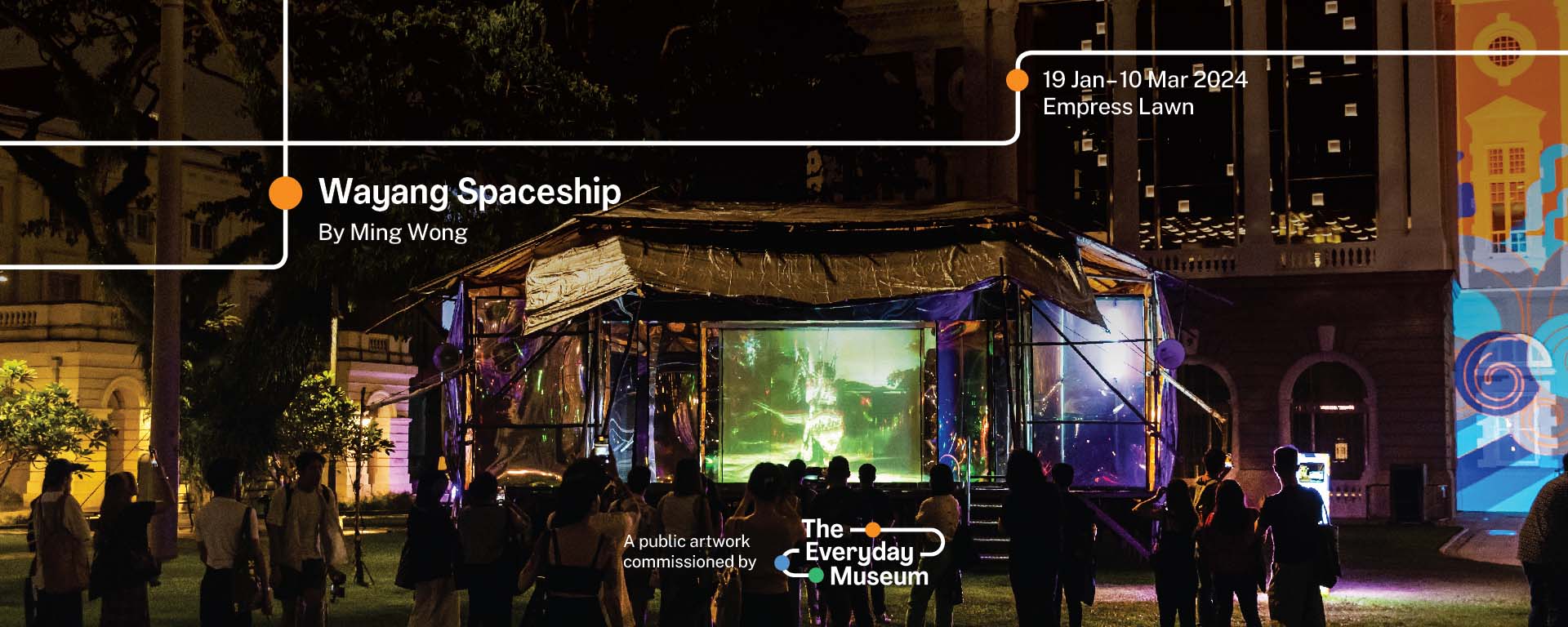10AM–10PM
Empress Lawn, in front of Victoria Theatre and Concert Hall (10 Empress Pl 179557)
A Wayang Spaceship has landed on our shores. Alongside the industrial, technological and ecological crises that have taken place throughout time, it also stands witness to our place in the cosmos. During the day, the Wayang Spaceship is seemingly dormant, its reflective surfaces mirroring the bustling traffic around the container seaport. Its own inactivity is interrupted by the occasional stray radio transmission relayed from another dimension.
At dusk, the Wayang Spaceship reclaims its former role as a travelling Chinese theatre, illuminating the past, present and future with an operatic symphony of light, sound and image, as though it is livestreamed from the memory of a scholar-warrior, a time travelling consciousness who moves freely between the past, present, and future. Each day, after the Singapore Art Museum closes, the Wayang Spaceship activates with light, sound and film, allowing the public to commune with this solitary figure of Chinese opera.
The Wayang Spaceship will evolve over a two-year period featuring a range of performances and access programmes. It is commissioned by The Everyday Museum, a public art initiative by Singapore Art Museum, and made possible with the generous support of Sun Venture.
To find out more about the programmes and discover #ArtWhereYouAre, please visit
Credits
Conception and Lead Artist: Ming Wong
Architecture and Design: Randy Chan, ZARCH Collaboratives
Wayang Stage: Lee Beng Seng
Lightboxes and Projection: Liam Morgan
Video: Eric Lee
Sound: Wu Jun Han
Sound design consultant: Shah Tahir
Technical Production: ARTFACTORY
Graphic Design: CROP.SG
Curatorial and Texts: Shabbir Hussain Mustafa, Syaheedah Iskandar
Production Management: Teo Loo Bing
Supported By:

The Everyday Museum brings art to everyday lives and demonstrates the possibilities and potential of art and creativity for our society. Siting projects in publicly accessible spaces, these are artworks that will spark curiosity, activate imagination and ignite conversations, transforming everyday experiences into memorable encounters that offer new perspectives on life and society. Dedicated to supporting artistic practice in the public sphere, The Everyday Museum is a platform for creative production and experimentation, where every space is a cultural space, created for and with communities. Its diverse programming creates physical and virtual nodes for engagement and interaction where everyone can participate.
The Everyday Museum is a public art initiative of the Singapore Art Museum and part of the museum’s new direction of infusing meaningful art encounters into the everyday, inspiring change through art and collaborations.
The world of cinema is Ming Wong’s gateway to imagination. In many of his works, he deliberately miscasts performers in order to reveal how gender, race nationality, language, body-types and other categories are always a type of masquerade. Sometimes Wong plays all the roles himself—even learning different languages to do so. Wong has maintained a particular interest in Cantonese opera, having grown up with it in Singapore. Since 2012, he has also traced the history of science fiction in the Chinese-speaking world. This has resulted in a range of works that investigate various aspects of the modernisation of Cantonese opera, including its scenography and cinematic transformations, and its unlikely relationship with the development of science-fiction in China. Alongside Wayang Spaceship, other works that address the same theme include Windows on The World (I-IV) (2014–), Blast off into the Sinosphere (2014–), and Scenography for a Chinese Science Fiction Opera (2015). The latter was a work that invited the public to walk through the interior of spaceships inspired by cosmological design motifs from Chinese opera and science fiction movies from the Eastern Bloc. Wong represented Singapore at the 53rd Venice Biennale in 2009 with Life of Imitation, which won a special mention. www.mingwong.org
all resources



